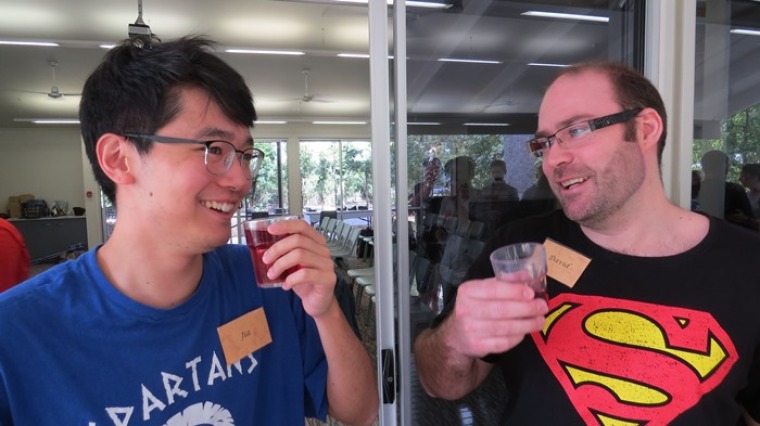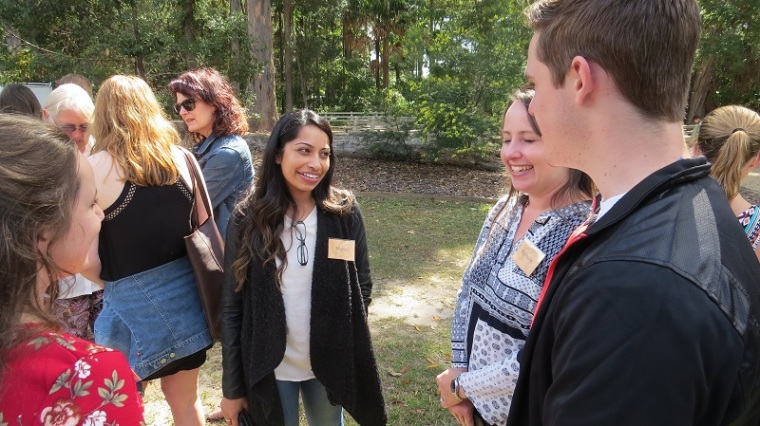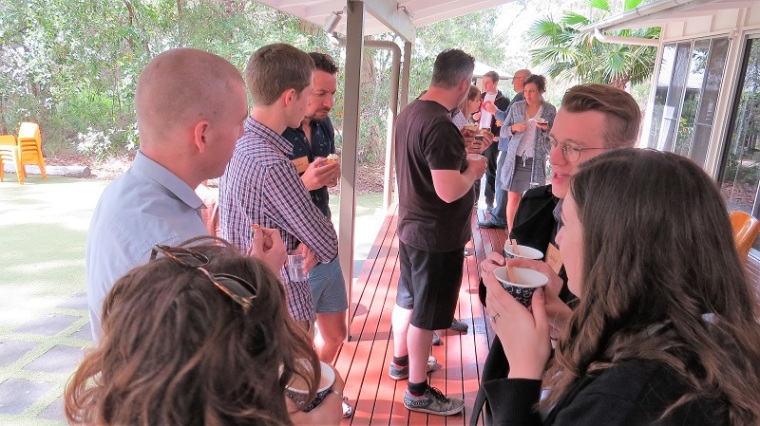
Jia Pan Xiao and David Goodwin at the 2017 young writer conference
Some years ago the HeraldSun ran an article on a woman sun-baking in a G-String in her back yard in Mt Martha and a photographic company was commissioned to get suburb photographs for a real estate business and they in turn hired a photographic drone – you can see where we're going with this.
The question becomes therefore what, where and when (the three w's) might any business or individual running a blog, or newspaper or whatever can run any photograph and where are the demarcation lines drawn in relation to privacy.
There are some issues that need to be clear in this discussion, in that what might be considered as “news” in whatever context has a public interest disclaimer. One might dare to imagine the difficulty wherein every person pictured in any photograph in any news related (print or on-line) article required specific permission.
How many 'extras' (meaning those who happen-stance to be in the photograph) are there in any news photograph – albeit – passing by or in the distance – the determination of the height of the bar in such situations would be confusing to say the least.
Then there are international issues associated with jurisdictions. The classic example of this is an old one, we might recall as the 1930's drama of Prince Edward and Mrs Simpson whereby pressure was placed on the British Press to not only say nothing but withhold any photographs of them. But the same did not apply to the American Press whose news sheets and magazine couldn't get enough of the story.
A further inhibitor is that of the cost of any legal action. One might require a bank balance of $20,000 to even initiate legal proceedings and the tricky of the legal issues are such that legal firms who charge nothing but take a handsome portion of the rewards (as it were) generally steer clear of this issue as it is so uncertain.

Meenal Chandra at the 2017 young writer conference
More than news
The news scenarios only touch the surface when it comes to the issue of photographs. Recently I wrote an article on the nature of “small groups” and I illustrated that article with four photographs from our recent young writers annual conference. There are innumerable such conferences held around the world in any given day and all of these have photographs taken which end up in a variety of publications.
Again, the nature of such conferences and publicity is such that the very nature of the event and the publicity required to promote (whatever the organisation) is such that those photographs are the property of the “world' (as it were).
Obviously there are some inhibitors of good taste. One would not (or at least hope one would not) have published a photograph of someone 'picking their nose' or 'scratching an itch in an inappropriate place' and the like.
Clearly there are on-going real life situations whereby photographs are taken and be utilised in such areas that form part of a business, blog, family, ministry, whatever. The real estate business representative in the above article was unapologetic as it was a photograph taken to promote real estate in that area.
Telephoto lens and celebrities
The international glossy magazine and on-line salacious columns and sites would come to screaming halt and put literally hundreds of thousands of people out of work should telephotos lens photographs of celebrities be outlawed.
At the same time the celebrity business thrives on the telephotos lens enterprises and that business in turn would be sorely tested for publicity (good or bad). At the doctor and dentist I joke with the staff that the magazines available for reading are way too-recent – you need ones 5-7 years old so one can say with authority: “Wrong again, wrong again” ….
The Royals are the life blood of many glossy magazines and on-line sites and a very special photograph might be valued at hundreds of thousands of dollars. The Royals too function on good PR and the British tourist industry is enhanced by billions of dollars every year as a result.

Morning tea at the 2017 young writer conference
Is the photo lens a law unto itself
No, not at all. There are innumerable cases that end up in court. This site spells out Art law and again photographs taken in the street and this google site provides many instances where the courts were engaged.
This is an illustration I have kept - the ABC's Radio National Law Report on 4 November 2014 and other such stories since, ran a story about those people who perennial sue – they sue for anything and everything – they take up the courts time, they are rarely successful – they take up an enormous amount of time and the court's resources. Wisdom is sometimes the better part of valour and to ensure you stay clear of such.
Many schools and swimming pools prohibit photographs being taken unless specifically authorised such as class photos and perhaps a newspaper running a story to enhance learning to swim classes and swimming safety. There are many areas that remain unrestricted, such as parents and grand-parents taking photos of their children and grand-children at a public beach as they play in the surf is quite okay.
Clearly there are specific situations which are illegal and in bad taste, but it is also a dog's breakfast. However it seems that on the whole, each of us have certain freedoms and rights under the law to take photographs even if others happentance to be in the lens.
In my daily column in Christian Today I generally utilise four photographs. I ponder on all these issues.

Charis Jackson, Ashley and Miranda Menelaws at the 2017 young writer conference
Dr Mark Tronson is a Baptist minister (retired) who served as the Australian cricket team chaplain for 17 years (2000 ret) and established Life After Cricket in 2001. He was recognised by the Olympic Ministry Medal in 2009 presented by Carl Lewis Olympian of the Century. He mentors young writers and has written 24 books, and enjoys writing. He is married to Delma, with four adult children and grand-children. Dr Tronson writes a daily article for Christian Today Australia (since 2008) and in November 2016 established Christian Today New Zealand.
Mark Tronson's archive of articles can be viewed at
http://www.pressserviceinternational.org/mark-tronson.html

Dr Mark Tronson - a 4 min video
Chairman – Well-Being Australia
Baptist Minister 45 years
- 1984 - Australian cricket team chaplain 17 years (Ret)
- 2001 - Life After Cricket (18 years Ret)
- 2009 - Olympic Ministry Medal – presented by Carl Lewis
- 2019 - The Gutenberg - (ARPA Christian Media premier award)
Gutenberg video - 2min 14sec
Married to Delma for 45 years with 4 children and 6 grand children